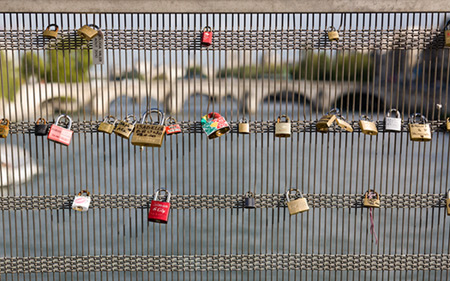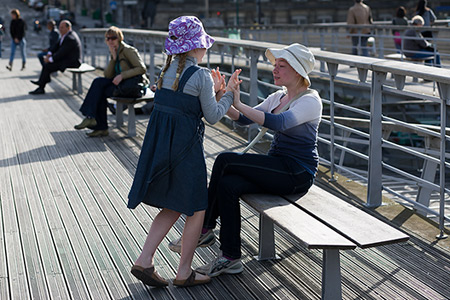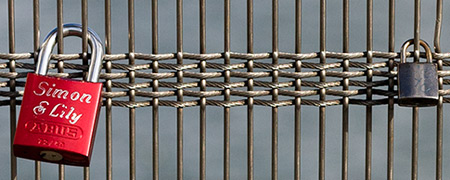Marking time in August 2012
Lovelocked in Paris
In the New York Times Agnes Poirier writes about a social phenomenon I noticed in Paris—lovers writing their names on padlocks, snapping the locks on the balustrades of bridges over the Seine, and throwing the keys into the river.
“The fools! They haven’t understood a thing about love, have they?” was the conclusion recently of a 23-year-old waiter at Panis, a cafe on the Left Bank with a view over Notre-Dame. At the heart of love à la française lies the idea of freedom. To love truly is to want the other free, and this includes the freedom to walk away. Love is not about possession or property. Love is no prison where two people are each other’s slaves. Love is not a commodity, either. Love is not capitalist, it is revolutionary. If anything, true love shows you the way to selflessness.

The locks remind me of graffiti—a selfish indulgence that ignores the harm it does to everyone else’s enjoyment of the place. Harrumph.

Of course I should have known that a social malignancy like this would have grown its own wikipedia page.

Henry Winstanley’s great lighthouse engraving
I have a few nice old prints of lighthouses, but none as wonderful as the one I just acquired. It’s from a copper plate engraved by Henry Winstanley (1644-1703)—an English engraver, merchant, and entrepreneur.
The engraving shows the lighthouse Winstanley built, with very great difficulty, on the Eddystone Rocks near Plymouth. The work started in 1696, and the lighthouse was finished and lit in 1698. Winstanley was not satisfied—he enlarged and strengthened the structure in 1899, and my engraving shows it in this improved form. The picture is surrounded by notes that set out the history of the project, and the intricate details of the design.
A piece of text at the top right of the plate (on the left hand page of the open book) adds this sad appendix:
The Light House thus built, Stood untill that Dreadfull Storm, of the 27th of November 1703: which destroyed both it and its Ingenious Projector Henry Winstanly Gent.
Many delightfull Curiousityes of his Invention Severall Drawings and Engravings of Copper Plates, he has left which are Preserved.
This Fatall Peice which was his last Work, may Serve for his Monument the House being his Tomb the Sea his Grave.
This is a very large print, more than a metre from top to bottom—too big to fit on a single sheet of the hand-made paper of the time, so four sheets were glued together before printing. I can see where it has been folded in half, then in half again, and bound into a book or a cover.
The fine detail and large size of the print make it difficult to digitise and reproduce in this blog. I have photographed the print in eight overlapping shots and stitched them together to make a composite image 11628 pixels high and 8484 pixels across—its not bad for a first attempt, and will do for now. I downsized it to 4000 pixels wide, zoomified it, and you can see it here:
Henry Winstanley’s Eddystone lighthouse of 1696-1699 was the first lighthouse to be built on a wave-swept rock. It was followed by a succession of other famous towers on the same site—the next one was designed by John Rudyerd (first lit in 1709); the next by John Smeaton (1759); and the last by James Douglass (1882). The 1882 tower is still in use, and the 1759 tower was dismantled and re-erected on the mainland at Plymouth as a memorial to its designer John Smeaton—I’ll add these two to my must see list.